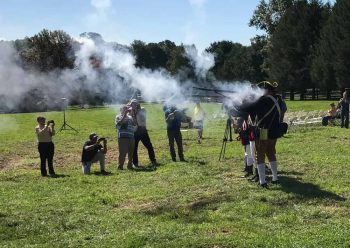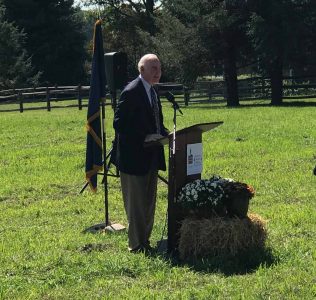By Mike McGann, Editor, The Times

1st Delaware Infantry Regiment fires musket volley in honor of those who fought on both sides during the Battle of the Brandywine, prior to a ceremony announcing the preservation of the Dilworth Farm, Friday.
BIRMINGHAM — More than two centuries ago, the Continental Army fought and lost a major battle here to the British, leaving it — and the Revolutionary cause — in dangerous peril.
Fortunately, as the history books record, George Washington was able to lead his army to the relative safety of Chester and preserve it to fight another day.
Today, another piece of the hallowed ground for that fight — which faced peril from development pressure — made it safely into the hands of those who would keep and preserve it for future generations.
Friday, local, county and federal officials, along with officials from Campaign 1776 and the Brandywine Battlefield Task Force, Natural Lands, and The Civil War Trust came together to announce the preservation of the 10.4 acre Dilworth Farm — a key portion of the Brandywine Battlefield, where both British forces marched on the attack, and later American forces were able to retreat to safety. During the rest of the weekend, hundreds of reenactors marked the 240th anniversary of the battle by recreating the battle.
Officials also expressed optimism that a nearby larger tract, Osborne Hill, an 88-acre property where British General Sir William Howe supervised the battle, would be added to the region’s preserved battlefields. A $1.13 million federal grant was announced in July to help pay for the tract, which straddles the township and neighboring Westtown, but talks to finalize the deal continue.
Two area Congressmen, Patrick Meehan (R-7) and Ryan Costello (R-6) were on hand to celebrate the formal turnover — as the bulk of the funding for came from federal funds, specifically, the Land and Water Conservation Fund’s American Battlefield Protection Program Battlefield Land Acquisition Grant — and it required a heavy push from both men to get the grant awarded to Pennsylvania — the first such grant in the commonwealth for a Revolutionary War battlefield. Chester County also contributed funds and the township offered support.
“Over the years, it has been wonderful to see so many partners coming together to preserve portions of this beautiful and historically significant battlefield,” Meehan said at the event. “This hallowed ground needs to be preserved as an outdoor classroom so future generations can understand the sacrifices our founding generation made. I am especially pleased that the American Battlefield Protection Program, through the Land and Water Conservation Fund, was used for the first time in the Commonwealth to preserve an important Revolutionary War battleground.”
Only about $10 million is allocated to the fund yearly for all projects in the U.S. — and the fund must be reauthorized in every budget. Costello noted that fighting for this project as well as to maintain the funding was tough but clearly worthy.
“The Land and Water Conservation Fund provides states and localities with the necessary resources to successfully implement conservation and historic preservation efforts, including the American Battlefield Protection Program,” Costello said. “In Southeastern Pennsylvania, conservation and education efforts create an important partnership in preserving open spaces for future generations to understand our history, and a perfect example of this partnership is the preservation of Brandywine Battlefield.”
Chester County and its partners have now worked to preserve some 400 acres of Revolutionary War battlefields, an effort to help preserve the both history of the county (and the entire country) as well a preserve the Chester County way of life. But as it the case with nearby Crebilly Farm, pressure on property owners for commercial and residential development of such properties remains high, so county officials offered strong thanks to federal agencies and outside groups working to preserve these sites.
“None of the battlefield would be preserved today if not for the work of the local community, partners and Brandywine supporters,” Cheser County Commissioners Chair Michelle Kichline said. “Although Chester County has invested roughly $4.8 million in the preservation of the Brandywine Battlefield, it is critical to have support from the National Park Service through programs like the American Battlefield Protection Program, and from all of our nonprofit conservation partners.”
Friday’s event marked another accomplishment for the Brandywine Battlefield Task Force, which has been working to preserve as much of the original battlefield in Chester and Delaware counties as possible, to offer future generations opportunities to learn about the war and specifically, the Battle of the Brandywine, arguably the biggest battle of the war.
“Preservation of the Dilworth Farm expands opportunities at the battlefield for public interpretation,” said historian Andrew Outten, chair of the Brandywine Battlefield Task Force. “Of any battle fought on American soil during the RevolutionaryWar, Brandywine had the most combatants engaged — 30,000—witnessed the most casualties and covered the largest area.”
“The Battle of Brandywine was the first fight to pair Washington and Lafayette, an influential aristocrat who helped persuade France to support the American revolutionaries in what became a global war.”





